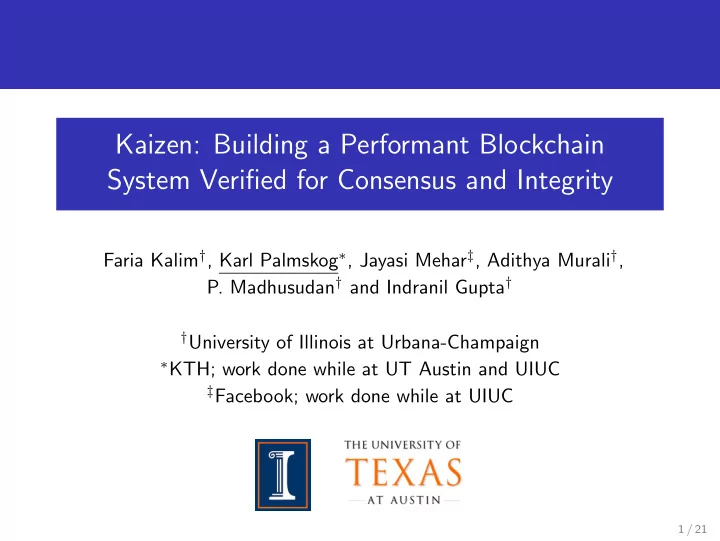

Kaizen: Building a Performant Blockchain System Verified for Consensus and Integrity Faria Kalim † , Karl Palmskog ∗ , Jayasi Mehar ‡ , Adithya Murali † , P. Madhusudan † and Indranil Gupta † † University of Illinois at Urbana-Champaign ∗ KTH; work done while at UT Austin and UIUC ‡ Facebook; work done while at UIUC 1 / 21
Blockchains and Cryptocurrencies Ethereum Bitcoin transactions+state dissemination distributed ledger consensus Algorand Nakamoto Ouroboros 2 / 21
Consensus Protocol Challenges Distributed protocols need to handle: communication delays (asynchrony) node crashes, corruption message drops, duplication, forging Protocol implementation challenges: conformance to protocol specification node-local performance absence of bugs compromising safety 3 / 21
Consensus System Formal Verification Project Paper Protocol Tool LOC Disel POPL ’18 2-phase commit Coq 5k+ Verdi Raft CPP ’16 Raft Coq 50k+ Velisarios ESOP ’18 PBFT Coq 50k+ Ironfleet SOSP ’15 Paxos Dafny 20k+ Toychain CPP ’18 proof-of-X Coq 10k+ 4 / 21
Interactive vs. Mostly-Automated Verification Coq proof assistant - much training required + explicit proofs + many libraries - purely functional (extraction to OCaml/Haskell) Dafny verification environment + less training required - implicit proofs - few libraries + functional & imperative (C# code generation) 5 / 21
Our Contributions novel combination of Coq & Dafny to build performant and verified blockchain system, Kaizen methodology based on continuous refinement adapted & instantiated Coq model translated Coq code (not proofs) to Dafny imperative code refined C# code and linked to network shim performed evaluation measuring minting and consensus time 6 / 21
Methodology Overview ∗ STAGE I STAGE II STAGE III Abstract Translation of Translation to Implementing protocol abstract Refinement to Refinement in executable Refinement in application design & protocol to imperative Dafny for code on a Coq specific verification in Dafny code in Dafny performance distributed functions in C# Coq contracts network PHASE 1 PHASE 2 PHASE 3 PHASE 4 PHASE 5 PHASE 6 PHASE 7 Dafny experts and Coq experts Dafny experts Systems engineers systems engineers ∗ system is fully verified until Stage III 7 / 21
Stage I: Modeling and Verification Using Coq 1 encode system in higher-order functional language (Gallina) 2 prove specification interactively using powerful tactics 3 check soundness of every low-level step Coq tactics proof term user logic engine type checker subgoals 8 / 21
Toychain Examples Record Block := mkB { prevBlockHash : Hash; txs : seq Transaction; proof : VProof }. Record State := mkS { id: Address; peers: seq Address; forest: map Hash Block; txpool: seq Transaction }. Definition valid_chain_block (bc:seq Block) (b:Block):= VAF (proof b) bc (txs b) && all [pred t | txValid t bc] (txs b). 9 / 21
Toychain Results and Extensions Toychain proves that in quiescent state, all nodes know the same (canonical) chain we added support for coinbase transactions we added checking of proof-of-work validity of chains we changed Toychain nodes to avoid unncessary messages All changes are proof-preserving and now merged into Toychain. 10 / 21
Stage II: Refinement and Verification Using Dafny 1 encode programs and their contracts in imperative language 2 try to prove automatically that contracts are fulfilled 3 add more annotations if necessary Dfy program IVL program VCs user Dafny Boogie Z3 ? 11 / 21
Dafny Examples datatype Block = Block(prevBlockHash : Hash, txs : seq<Transaction>, proof : VProof) datatype State = Node(id : Address, peers : seq<Address>, forest : map<Hash,Block>, txpool : seq<Transaction>) class StateImpl { var id : Address; var peers : . . . ; var forest : . . . ; var txpool : . . . ; ghost var st : State; predicate Valid() { . . . } method ProcMsgImpl(from : Address, msg : Message, ts : Timestamp) returns (pt : seq<Packet>) requires Valid(); ensures Valid(); ensures st = procMsg(old(st), from, msg, ts).0; ensures pt = procMsg(old(st), from, msg, ts).1; { . . . } } 12 / 21
Stage III: Refinements in C# block and proof-of-work generation define and inject miner rewards store pre-computed chains add network shim based on UDP 13 / 21
Implementation Architecture Verified Implementation Verified Implementation Blockchain Bitcoin Blockchain Bitcoin … Functions Functions Functions Functions Message Queue Message Queue Shim Layer Shim Layer … Network Peer Network Peer 14 / 21
Evaluation Setup metrics: block minting time and consensus time use 30-node cluster of 2.4GHz processors w/ 64GB RAM baseline: performance of stock Bitcoin implementation workload: traces of arrival times of 50 transactions from realistic dataset 15 / 21
Evaluation: Block Minting Time Time to Mint Block (Seconds) 0.8 0.6 0.4 0.2 0.0 100 500 1000 Initial Number of Blocks Bitcoin: 30 Nodes KznCoin: 20 Nodes KznCoin: 10 Nodes KznCoin: 30 Nodes 16 / 21
Evaluation: Consensus Time Time to Consensus (Seconds) 2 1 0 100 500 1000 Initial Number of Blocks Bitcoin KznCoin 17 / 21
Evaluation: Scalability 10 Time to Consensus (Seconds) 8 6 4 2 0 10 20 30 Cluster Size Bitcoin - 50 Bitcoin - 250 KznCoin - 50 KznCoin - 250 18 / 21
Components and Effort Component Lines of Code Coq refinement ≈ 1k Dafny refinement ≈ 5k C# refinement ≈ 1k C# network shim ≈ 4k Development effort ≈ 6 person months across four people 19 / 21
Lessons Learned and Future Work holistic expertise necessary in Coq/Dafny/systems for Kaizen “easy” change can require large changes at earlier stages local node computation took most effort to optimize (rather than network messaging) future Coq proofs of Toychain Byzantine tolerance transferrable to Kaizen (see WIP by Gopinathan and Sergey, CoqPL ’19) 20 / 21
Conclusion system development methodology combines interactive and mostly-automated verification, Coq & Dafny verified executable blockchain system Kaizen evaluation gives encouraging results on performance More information: GitHub: https://github.com/palmskog/kaizen contact me: Karl Palmskog palmskog@kth.se 21 / 21
Recommend
More recommend